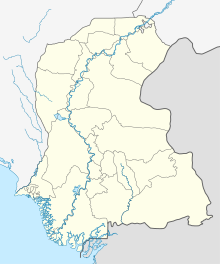| Siege of Debal | |||||||||
|---|---|---|---|---|---|---|---|---|---|
| Part of Umayyad campaigns in India and Umayyad conquest of Sindh, Muslim conquests in the Indian subcontinent | |||||||||
| |||||||||
| Belligerents | |||||||||
|
| Kingdom of Sindh | ||||||||
| Commanders and leaders | |||||||||
|
| Unknown (nephew of Raja Dahir) | ||||||||
| Units involved | |||||||||
|
6,000 Syrian Cavalry |
4,000 Rajputs 3,000 Brahmins | ||||||||
   | |||||||||
The siege of Debal, also known as the siege of Debul, took place in the autumn of 711 AD, in which the Umayyad forces under Muhammed Ibn al-Qasim besieged Debal, a city under the Brahmin dynasty of Sindh ruled by Raja Dahir. Umayyads defeated the inhabitants of the order on the order of Governor of Iraq Al-Hajjaj and captured it.
In 711, Muhammed ibn Qasim marched towards Debal with 6,000 Syrian cavalry and 3,000 camelry with a good number of Arab soldiers. The city was commanded by a nephew of King Dahir with an army of 4,000 Rajputs and 3,000 Brahmins. Umayyad forces encamped outside the city walls for seven days waiting for the permission letter to attack. On the eight day, Muhammed ibn Qasim received the letter from Al-Hajjaj and eventually the Umayyad Army scaled the walls of Debal and its people surrendered.
References
- Wolseley Haig. The Cambridge History Of India Volume III. BRAOU, Digital Library Of India. At The University Press Cambridge. p. 2.
- ^ Board, Pratiyogita Darpan Editorial. Pratiyogita Darpan Extra Issue Series-16 Indian History–Medieval India. Upkar Prakashan. p. 36.
- The Muslim World. Motamar al-Alam al-Islami; World Muslim Congress. 2001. p. 48.
- Kalichbeg (1900). The Chachnamah An Ancient History Of Sindh. p. 81.
- Indian Armed Forces Yearbook. Indian youth. 1961. p. 488.
- Mahajan, V. D. (2007). History of Medieval India. S. Chand Publishing. p. 17. ISBN 978-81-219-0364-6.